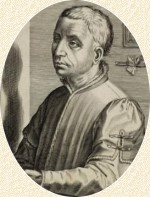|
Rogier van der Weyden (French: Roger de la Pasture) was one of the most important Early Netherlandish painters in the 15th century, whose altarpiece “The Descent of Christ from the Cross” is world-famous.
Born: in 1399 or 1400 in Tournai
Died: 18 June 1464 in Brussels
The painting style of Rogier van der Weyden contains a high degree of realism, which is probably due to his teacher Robert Champin, in whose studio he is trained as a freemason of the guild of Tournai. Van der Weyden settles down in Brussels shortly afterwards. Guided by the work of Jan van Eyck, Rogier van der Weyden also develops a unique feeling for perspective design and depth. Even though in his most important work, “The Descent of Christ from the Cross”, which is located at the Museo del Prado in Madrid, still the typical, flat-faced gold foundation can be seen, he groups the highly naturalistic figures represented in a way that they appear in front, behind and above each other. The artist also makes a name for himself in the neighboring countries of the Netherlands. In his hometown of Brussels, there are other important altarpieces, which nowadays are considered among the most important Early Netherlandish art works. They can be viewed at the most important museums around the world.
|
 |
|
|